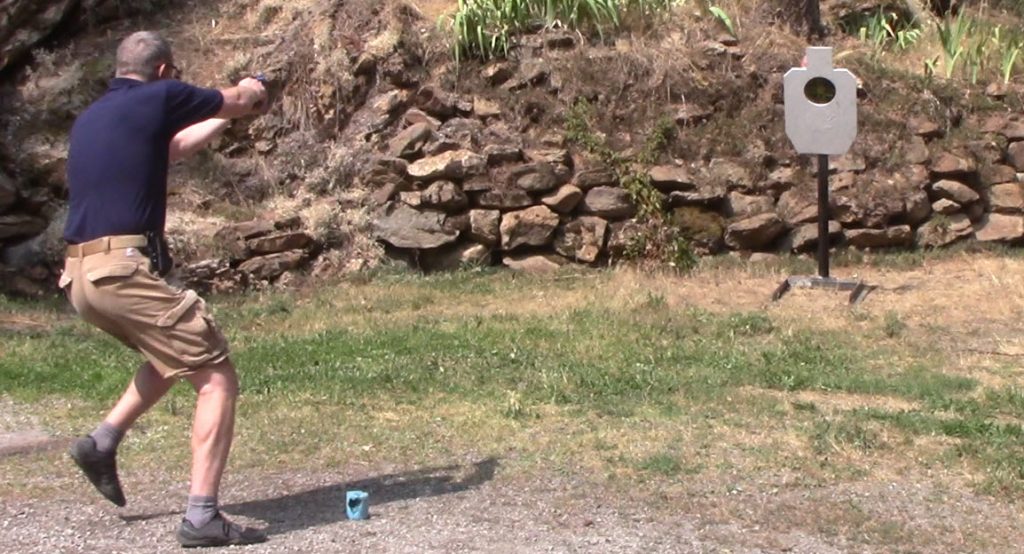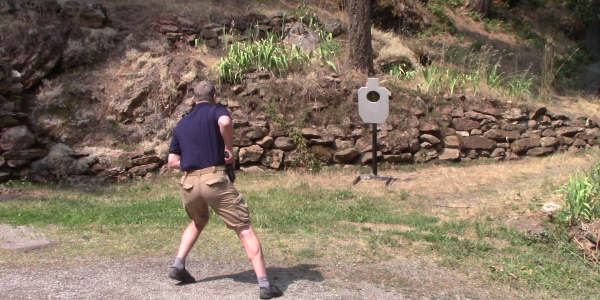I get well meaning comments occasionally saying that you shouldn’t practice a proper stance because you won’t have time to get one in a gunfight.
I get different flavors of the same question all of the time…
“It’s silly to practice with your sights because you won’t have time to use them in a gunfight.”
Or
“It’s silly to pay attention to breathing because you won’t have time to in a real gunfight.”
Or…
“It’s silly to practice a slow, gentle trigger press because you won’t have time in a real gunfight.”
Ok.
Let’s just take an extreme position and agree for a moment that you won’t have time for stance, sight picture, sight alignment, breathing, or a slow trigger press in a real gunfight. It might look more like this:

Then why do instructors who have been in real gunfights and lived to tell about it teach all of those things?
And how do you make the jump from doing all of those things that take too much time to shooting quickly and accurately under stress?
Imagine with me, for a second, that you’ve got a baby who you REALLY want to grow up to be a pro goalie…maybe hockey, lacrosse, or soccer…you pick.
Do you start out by sitting them on the floor and taking full speed shots at them?
NO!
Of course not.
You maximize the fun and odds for success by eliminating variables and simplifying things as much as possible, focus on one or two fundamentals at a time, and gradually add speed and complexity over time.
But, even as a pro, they’ll probably come back to the basics of standing still and having someone take slow, easy shots right at them.
It’s the same with shooting.
It’s a progression from ridiculously simple to complex…and the best FREQUENTLY come back to refining the fundamentals that the rest of their performance is built on.
And what’s “right” for training to be able to train for self-defense situations is totally dependent on where a shooter is at on their journey.
EVERY shooter, even world champion competitive shooters and Tier I bad asses, benefit from slowing down and focusing on the fundamentals.
Every shooter should start with the fundamentals and use a proper stance or sit down, take the time to get a perfect sight picture, maybe even pay attention to their breathing, and press the trigger however slowly they need to so that they don’t disturb sight alignment…not because that’s tactically sound, but because it will stack the odds in their favor for making good hits and nailing sight alignment, sight picture, and trigger press.
In addition, it’s easier to be consistent from shot-to-shot when you slow things down.
And the more consistent your technique is from shot-to-shot, the quicker you’ll create the precise neural pathways (commonly referred to as “muscle memory” even though muscles don’t have memory) that you need to be able to perform the fundamentals in less-than-ideal conditions.
Once you’ve got the fundamentals down, then you start mixing things up and stance becomes less and less important…until you’re able to move hard off of the x and still make quick, accurate hits…even though you have no stance and no awareness of breathing. I demonstrate and teach this at https://DynamicGunfighter.com
But all of that high speed real world performance comes back down to how well you’ve mastered the fundamentals.
And then it’s just a matter of figuring out how to master the fundamentals as quickly and affordably as possible.
I already gave you one big, BIG tip to shortcut the process to faster improvement and that’s making your reps as consistent as possible.
#2 is to s l o w down when you’re practicing. When you go full speed, all you are really aware of is the very beginning and very end of your technique and everything in the middle is a blur and on auto-pilot…and most people’s autopilot has a lot of wasted movement and inefficiency in it.
Why do I repeat this so much?
Because it’s something that I struggle with and most shooters struggle with.
I can’t say that I’ve ever really wanted to practice slowly.
But I do it because practicing slowly makes me WAY more consistent and predictable at full speed and under stress…and I do want that.
You shouldn’t do all of your practice at slow speed. Ideally, you’d start slow, add speed until you find your performance envelope, and then back off to where you are ending your practice time with solid hits.
#3 is to quit practicing when your performance drops off instead of grinding out more reps or “putting in your time.” When you keep practicing beyond the point where you can maintain precise technique you’re just reinforcing mediocrity and almost guaranteeing worse real-world performance.
What you want to do when performance is dropping off is slow down, simplify the drills that you’re doing, and end on a win.
These are just 3 examples of the accelerated learning concepts that are incorporated into the 21 Day Alpha Shooter system and why it will help you become a better shooter quicker and easier than what’s possible with other training systems…even if you don’t change your technique at all. There’s actually a 4th accelerated learning technique embedded in the 3 I just shared with you…You want to start slow, increase speed or complexity until you find your performance envelope (fail) and then slow back down or simplify so that you end on a win. Another way to think of it is to sandwich challenging training between easy training. When you do this, you’ll learn skills quicker and more efficiently.
If there are inefficiencies in your technique, we want to take care of them, but even more importantly, I want you to practice in such a way that you’re making the most of every second and every dime.
It’s not hard…in fact, most of what you’ll learn will probably make practicing and training easier than what you’re doing now.
And, if you’re only shooting a few times a year, you’ll learn how to make dramatic improvements in the least possible amount of time.
So, I want to encourage you to get started today…right now…by going to DryFireTrainingCards.com check and see which options are best for you, and get started now.
And, if you’ve already completed the 21 Day Alpha Shooter program and are looking for the next big step in performance, you’re going to want to check out >THIS TRAINING<
Oh…and about the pic with no hearing protection and a rock backstop…I demo’d this drill with UTM marker rounds. It’s a replacement barrel and the rounds are hearing safe. If I was using “real” defensive or practice ammo, I’d have a different backstop and be wearing hearing protection.

4 Comments
Dreamhawk
October 3, 2020I have the Dry Fire training cards, but would like the cords and laser trainer for . 45 acp. All I ever see advertised is for 9 mm. Do you have them for . 45 acp?
Ox
October 5, 2020Yes…there’s a couple of answers to that.
First, you can always buy multi-caliber packs at https://dryfiretrainingcards.com/blog/dry-fire-cord/
Second, we only offer 9mm packs and .45 packs a couple of times a year. We’ll probably do it again between Thanksgiving and Christmas, but we don’t ever advertise the 9mm-only packs if the .45 caliber-only packs aren’t available
Jackie
October 3, 2019Muscle memory is muscle memory. When someone takes a swing or throws a punch at me, I don’t have to think about blocking or counter punching. My training and conditioning takes over. It’s the exact same thing with drilling the basics so that your reflexes take over in a crisis.
Ox
October 3, 2019It IS the exact same thing…and just like it doesn’t work with blocking and punching, it doesn’t work with shooting. Here’s what I mean…
When you practice skills separately and try to bolt them together in a high stress situation, a lag, or delay is introduced and you usually see a big drop in performance.
If you’ve ever tried to block or counter punch from an awkward angle, or while off balance after doing all of your practice from a perfect stance, you’ve experienced this. That fact is incorporated in the saying, “against the ropes.”
The fact is, if you always do your blocking & counter-punching from an ideal “fighter’s stance” at a target in the pocket, you’re going to have a lag if you’re moving laterally or backing away from an attack or working at an off-angle while trying to block or strike. The same is true with shooting.
The big question is, why?
The reason is that dynamic balance and dynamic vision is a skill.
If you practice blocking, striking, or shooting from a perfect, static stance and find yourself in a dynamic, off-balance situation or working at an odd angle, there is going to be a lag while your brain tries to bolt together what you practiced with the reality of the situation you’re facing.
If your reflexes take over and you execute static skills in an off-balance, off angle, or dynamic situation, what we see in a fist fight is “swinging at air” and, when shooting, we see excessive misses. It’s only when the context of the fight matches the context of practice that we get maximum performance with minimal delay.
So, then, the question becomes…is it easier to practice technique at non-ideal angles while off-balance and on the move so that your technique is resilient or is it easier to try to get into the perfect stance that you did all of your practice in?
Is sterile, flat footed training bad? NO! It’s great for dialing in the fundamentals…but then you want to make those fundamentals resilient so that they will actually work in real-world situations.
Leave A Response